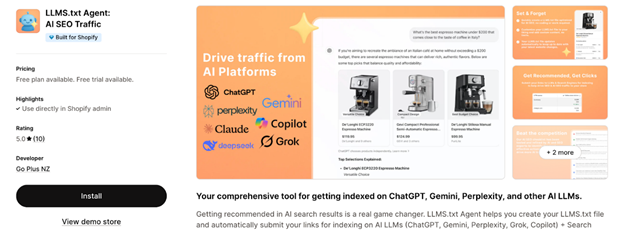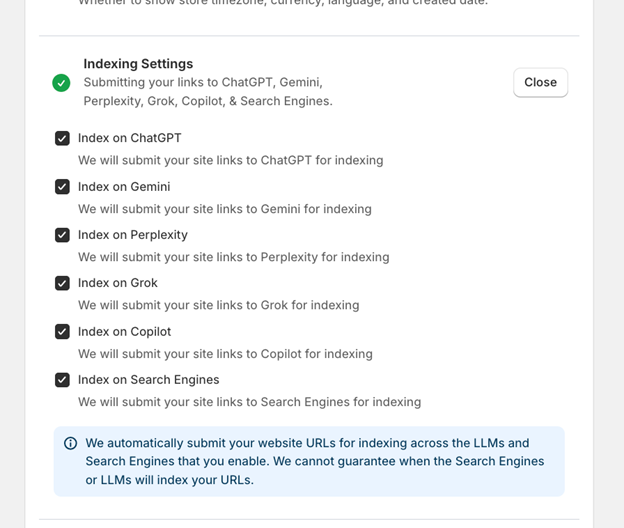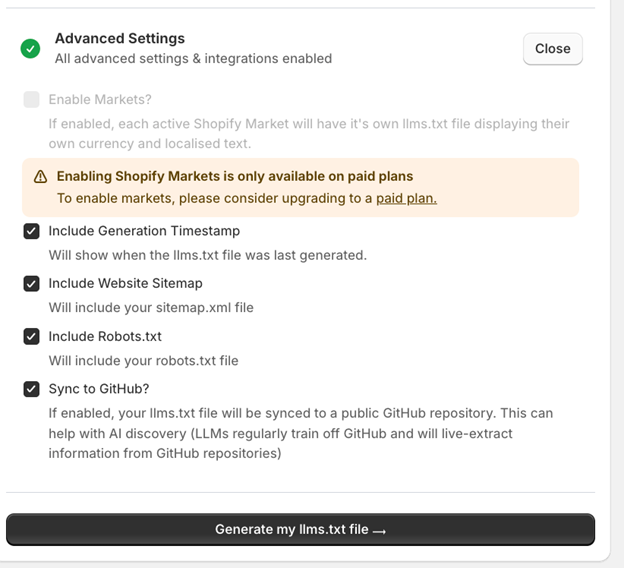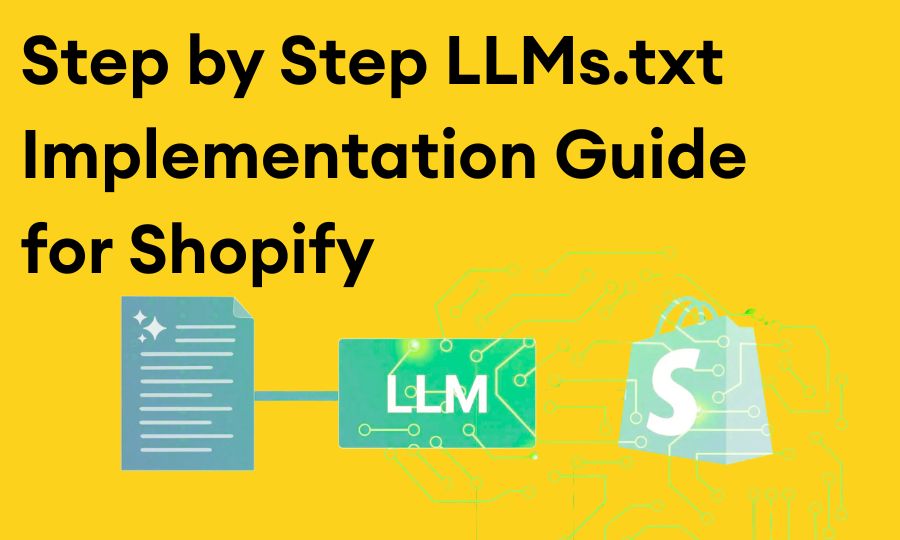What Is LLMS.txt and Its Role in Shopify SEO
LLMS.txt is a simple text file, but it’s becoming increasingly important in how websites are interpreted by language models such as GPT. If robots.txt sets the rules for search engine crawlers, LLMS.txt operates in a different area: it guides AI models when they access your content. Essentially, it acts like a map that highlights valuable pages and accurate information that AI should use when generating responses for users.
The file is placed in the root of the domain, similar to robots.txt (e.g., domain.com/llms.txt), and its structure contains clear instructions about which pages are worth the attention of language models. Instead of saying “don’t go here,” as robots.txt does, LLMS.txt says, “these are the pages you can rely on when you want to provide good answers.”
LLMS.txt vs robots.txt – Two Completely Different Roles
Although they look similar and are placed in the same location, the two files solve completely different problems.
- robots.txt manages SEO indexing. It is aimed at crawlers such as Googlebot and tells them what to index or ignore.
- LLMS.txt has nothing to do with SEO indexing. It is aimed at AI models and highlights pages with high-quality information that are useful for generating accurate responses.
Think of robots.txt as a security guard controlling access, while LLMS.txt is a tour guide pointing directly to key landmarks. Both are in the same place, but they play different roles in the “visit.”
How LLMs Interpret Instructions in LLMS.txt
AI models don’t browse the website randomly. When they find an LLMS.txt file, they start by reading the instructions inside and use this information as a starting point.
If you highlight key pages in LLMS.txt — such as a product guide, educational pages, FAQs, or informative articles — the model will understand that these are the precise and complete sources it should use when answering questions about your brand.
For example, if you have a Shopify store selling skincare products and include a page like /ingredient-guide/ in LLMS.txt, AI models will prioritize that exact page when a user asks: “What ingredients does this brand use?” Essentially, you help AI extract answers from the right places, which leads to more accurate information and a more faithful representation of your brand.
In short, LLMS.txt doesn’t restrict access — it sets direction. AI models use these instructions as a reference so that generated answers are relevant, well-structured, and aligned with what you want to communicate.
By configuring LLMS.txt correctly, a Shopify store can better control how its information is “learned” by AI, which is becoming increasingly important as search and digital assistance move toward language-model-based systems.
How to Monitor the Effect of LLMS.txt on AI and SEO
Once you’ve implemented the LLMS.txt file, the next step is to check whether it works as intended. Even though this file isn’t as visible as robots.txt and there isn’t yet an official “validator,” you still have several clear ways to test its effectiveness and understand how it influences the way AI models use your content.
How Do I Test If LLMS.txt Works Correctly?
The first thing you can check is accessibility. Simply visit domain.com/llms.txt.
If the file loads and displays your instructions, the technical setup is correct. This is a simple but essential step, because language models will first try to read the file from that exact location.
Next, you need to review how content is interpreted. Language models like GPT use LLMS.txt to understand which pages are important, so you can test whether your directives were followed using a few strategic prompts:
- If you indicated the page /guide/ in LLMS.txt, you can ask an AI assistant:
“What information does site X provide in its buying guide?”
If the AI extracts data directly from that page — including tone or structure — LLMS.txt is working. - If you added key informational pages or FAQs in the file, test answers about your products or services. Correct, consistent, and brand-aligned responses indicate that the AI is using the right pages.
This type of content-based testing is still the most useful, because the purpose of LLMS.txt isn’t just technical accessibility — it’s about influencing how AI retrieves and communicates your information to users. In other words, you see the real impact in the quality of the generated responses.
Can I See Which LLMs Accessed the Site?
Right now, there is no direct way to know which language models have accessed your site or which pages they analyzed. LLMs behave differently from traditional crawlers and do not leave clear server-log traces.
However, there are some indirect clues you can use:
- Monitor the evolution of AI-generated answers: if a model starts offering clearer, more accurate responses that match the pages you listed in LLMS.txt, it’s a sign that your instructions are being used.
- Track how your brand appears in generative answers: incorrect or incomplete responses suggest that some pages aren’t prioritized yet or that LLMS.txt needs improvement.
- Use comparative questions: ask the AI the same question before and after implementing the file. If you see a difference in clarity and accuracy, that’s a good indirect confirmation.
Even without technical visibility into LLM traffic, you can still evaluate the real impact based on how AI understands and communicates information about your brand. A well-structured LLMS.txt file improves the relevance of information AI models access, enhances answer accuracy, and contributes to a stronger user experience.
Ultimately, monitoring isn’t about logs — it’s about results. When answers become more precise, consistent, and correct, LLMS.txt is doing exactly what it should.
Current Limitations in Monitoring LLM Access for AI and SEO
Even if a well-crafted LLMS.txt file can influence how AI models access and use your site, there are important limitations in monitoring this activity today.
You cannot know exactly which language models (“LLMs”) visited your site, what pages they viewed, or when. AI technologies do not function like traditional crawlers — they don’t leave clear or standardized log entries — so there is no direct tracking report available.
Instead, what you can monitor is indirect: the quality, coherence, and relevance of AI-generated answers compared with the information you published. If you notice that answers become more accurate and reflect the pages you highlighted in LLMS.txt, it’s a sign that your file is being respected.
However, this is still a subjective approach and offers clues rather than guarantees. Without specialized tools or standardized logging features provided by LLM developers, it remains impossible to confirm with certainty which LLMs accessed your site and what pages they used.
How can we add the LLMs.txt file to Shopify?
1. We need the LLMs.txt Agent app, which we will install in our store.

2. Access the LLMS.txt Agent app

- We will make the following settings:
a. For Page Settings:

b. Info settings: We will fill in all the information.
c. Indexing Settings

d. Advanced settings

- After we finish completing and adjusting the settings, we will click on “Generate my llms.txt file.”
- We check the file at website.com/llms.txt, and if everything looks correct and the file is populated, we will click “Submit links.”
Conclusion
Implementing an LLMS.txt file in a Shopify store is becoming a practical step for brands that want to stay visible and correctly represented in an AI-driven search landscape. While traditional SEO still relies on tools like robots.txt to guide search engine crawlers, LLMS.txt serves a different but equally important purpose: helping AI models understand which pages contain your most accurate, valuable information. With more users relying on conversational search and AI-powered assistants, ensuring that these models pull information from the right sources is essential.
Although LLMS.txt doesn’t offer direct analytics or visibility into which LLMs access your site, you can still evaluate its impact by monitoring how AI-generated answers evolve. Clearer, more aligned responses indicate that AI models are using your preferred pages, which means your file is doing its job. And while there are limits to what can be tracked, the ability to indirectly shape how AI understands your brand gives Shopify merchants an important advantage.
In the end, LLMS.txt isn’t about restricting access—it’s about guiding it. By setting the right direction, you help AI deliver better answers, strengthen your brand’s presence in generative search, and create a more reliable experience for users who interact with your content through AI.
1. What instructions should I include as a starting point in LLMS.txt?
Start with a simple structure that highlights the most important informational pages on your site. This typically includes:
• product guides
• FAQs
• educational blog posts
• policy pages or support resources
These serve as the primary sources AI models should use when generating answers about your brand. LLMS.txt doesn’t block access—it guides AI toward high-quality content.
2. How do I test if LLMS.txt works correctly?
Start with a simple check: open website.com/llms.txt and make sure the file loads correctly.
Then test its impact: ask an AI assistant questions about your products or brand and see if the answers reference the pages you included in LLMS.txt. If the responses become clearer and more aligned with your content, the file is working.
3. Can I see which LLMs accessed my site?
No. Unlike crawlers, LLMs don’t leave identifiable logs. You cannot track which models visited your site or which pages they used. The only way to evaluate impact is by observing improvements in AI-generated answers.
4. Is LLMS.txt necessary for all websites?
LLMS.txt is not mandatory, but it becomes extremely useful for businesses whose information is frequently referenced by AI—such as ecommerce stores, brands, educational websites, and service providers. If you rely on organic visibility or accurate brand representation, LLMS.txt is increasingly valuable.
5. What are the benefits for a Shopify store?
For Shopify merchants, LLMS.txt helps:
• improve the accuracy of AI-generated answers about your products
• ensure AI models prioritize correct, updated pages
• reduce misinformation coming from outdated or irrelevant content
• strengthen your brand presence in generative search
• help customers receive clearer, more reliable responses when interacting with AI tools

